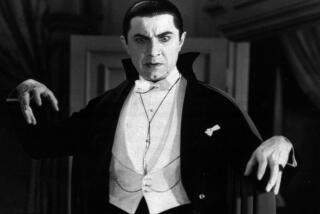A collection of horror tales for the 21st century
- Share via
What makes a horror story? Or what makes a horror story horrific? It isn’t just a matter of gruesomeness and gore. Creepiness helps, and a hint of the supernatural, but these aren’t essential. Moral degradation -- that’s more like it: the snuffing out of our fondest hopes about ourselves and the world. Is there a more ghastly scene in American literature than the one in Edgar Allan Poe’s “The Black Cat,” in which the narrator cuts out the eye of his innocent pet with a penknife?
Poe wrote long ago, before the world wars and the Holocaust and the gulag, before Cambodia and Rwanda; 21st century horror writers have an additional challenge. How can their made-up fright stories compete with those real, documented atrocities?
It isn’t easy. The 19 tales in Del Howison and Jeff Gelb’s second “Dark Delicacies” collection have a certain quaintness about them, even those written in a hard-boiled or raunchy style. More often than not they fall back on stock themes and situations of the genre, a few of which Poe used -- vampires, zombies, rats, pacts with the devil, haunted musical instruments and motor vehicles.
True, the authors sometimes decant old poison into new bottles. One of the most inventive yarns here is Max Brooks’ “Great Wall: A Story From the Zombie War.” The zombies are barely seen, and even then only in retrospect, after China’s surviving people have rebuilt the wall -- originally meant to keep out enemies from the north but now to pen the undead. The terror is displaced: We’re appalled not so much by the “million-strong assault swarms” of the zombies as by the inhuman sacrifices humans must make to prevail. Can a story of selfless heroism be a horror story? Apparently so.
James Sallis’ “Season Premiere” -- a wicked title indeed, once we understand it -- is a gem of rural Gothic, with warped echoes of “Of Mice and Men,” in which a swarm of livestock-eating rats proves even more ominous than the locals suspect. Barbara Hambly’s “Sunrise on Running Water” puts an English vampire aboard the Titanic. He survives the ship’s sinking, which Hambly describes with brio, but faces a new dilemma, bobbing in a lifeboat: What if dawn comes before rescuers do and burns him to a crisp?
As skillful as Hambly is, she may have miscalculated here. We don’t care about the vampire the way we cared about Kate Winslet and Leonardo DiCaprio in the movie. And if his fate is a matter of indifference to us, where does the horror lie? A similar objection applies to several stories in which the authors, for the sake of surprise twists, turn victims into villains or vice versa.
In “First Born,” for example, John Farris expertly sets up a Faustian bargain between a movie star and the demonic entity who greased his way to success. The star may be riding for a fall he deserves, but we feel some sympathy for him -- a fallible human. When the entity comes to collect and the tables are unexpectedly turned, fear and sympathy evaporate, though the story -- a werewolf tale now -- does become grimly amusing.
In “Stacy and Her Idiot,” Peter Atkins creates a tough-talking, butt-kicking lesbian narrator and a druggy L.A. milieu in hard, clean prose most detective novelists can only aspire to, but the ending, again, is where things go wrong -- it’s horrible, but it lacks the dead-on credibility of what led up to it.
Maybe, when we’re dealing with an emotion as primal as terror, too much fancy footwork is counterproductive. Ray Garton’s “Between Eight and Nine O’Clock” is basic but effective: An unfaithful husband hires a hit man to kill his wife, then discovers that his mistress will be in the line of fire. Can he intervene in time to save her? Steve Niles’ “The Y Incision,” a parody of burned-out detective stories, is a stew of body parts and sick humor, but it’s weirdly likable.
In Harry Shannon’s “A Host of Shadows,” a man is tortured with brain probes that touch the multiple selves lying within him. In Glen Hirshberg’s “I Am Coming to Live in Your Mouth,” a wife watches her husband die of cancer as a menacing figure in a trilby hat -- a hallucination? -- edges ever closer. Sophistication works here: In both stories, especially Hirshberg’s, fear arises from uncertainty; we feel as bewildered as the characters do.
Then there’s Joe R. Lansdale’s “Dog,” in which a mongrel the size of Stephen King’s Cujoor the Hound of the Baskervilles follows, then chases, a suburban bicyclist down streets and through the woods. The dog is ravenous, untiring, unstoppable, inexplicable. The man, to survive, must become a beast himself. Hardly more than a single, visceral scene of pursuit, it’s the simplest story in the collection -- and one of the scariest.
--
Michael Harris is a critic and author of the novel “The Chieu Hoi Saloon.”
More to Read
Sign up for our Book Club newsletter
Get the latest news, events and more from the Los Angeles Times Book Club, and help us get L.A. reading and talking.
You may occasionally receive promotional content from the Los Angeles Times.








